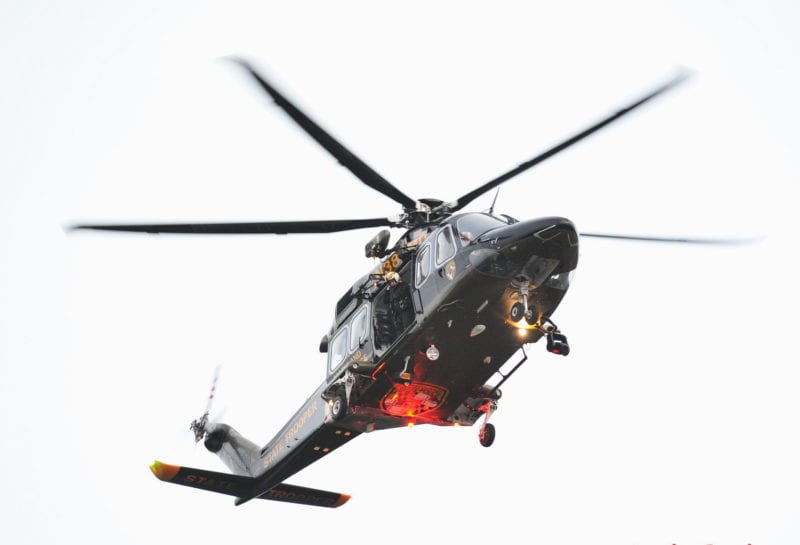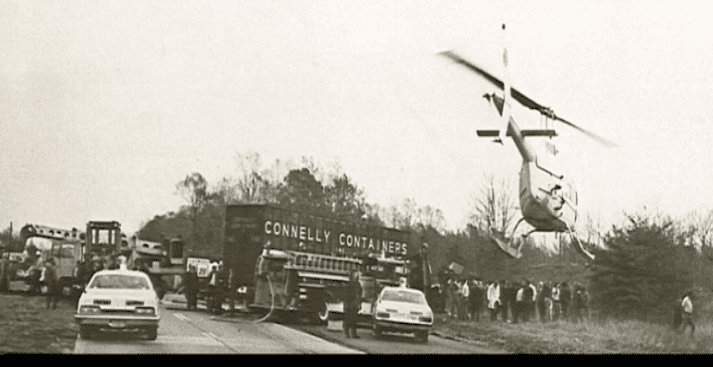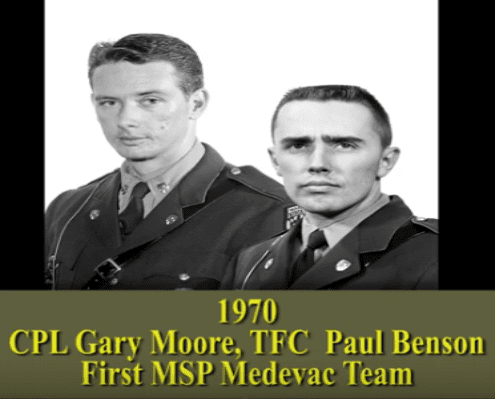 Today marks the 50th anniversary of the first patient ever transported by the Maryland State Police Aviation Command. On March 19, 1970, MSP’s “Helicopter 108,” crewed by pilot Corporal Gary Moore and Trooper First Class Paul Benson, was summoned to the Baltimore Beltway (I-695) and Falls Road for a patient involved in a motor vehicle crash.
Today marks the 50th anniversary of the first patient ever transported by the Maryland State Police Aviation Command. On March 19, 1970, MSP’s “Helicopter 108,” crewed by pilot Corporal Gary Moore and Trooper First Class Paul Benson, was summoned to the Baltimore Beltway (I-695) and Falls Road for a patient involved in a motor vehicle crash.
The two troopers, manning a turbine-powered Bell Jet Ranger helicopter, flew the injured motorist to the Center for the Study of Trauma, known today as the University of Maryland R Adams Cowley Shock Trauma Center. Much has changed since that first mission, but our goal to protect and improve the quality of life through the airborne delivery of emergency medical transportation has not.
The Maryland State Police Aviation Command today marks the 50th anniversary of the first civilian medevac mission flown in our state and the commencement of an integrated emergency medical system whose members have helped saved tens of thousands of lives since.
On March 19, 1970, at 11:20 a.m., Maryland State Police “Helicopter 108,” crewed by pilot Corporal Gary Moore and medic Trooper First Class Paul Benson, was summoned to the Baltimore Beltway and Falls Road for a patient involved in a motor vehicle crash. The two troopers, manning a turbine-powered Bell Jet Ranger helicopter, flew the injured motorist to the Center for the Study of Trauma, known today as the University of Maryland R Adams Cowley Shock Trauma Center.
“It took about three weeks before we got our first call because it was all new all over the state,” said retired Lt. Colonel Gary Moore in a Maryland State Police video that highlighted the department’s historic firsts. “That particular morning in 1970, [TFC] Paul [Benson] and I were the duty crew and landed on the highway, picked that patient up and took him down to the trauma center. That patient did live.”
The Thursday morning mission to the Brooklandville community in Baltimore County half a century ago held the distinction of the formal expansion of the Maryland State Police into the world of emergency medical services. The mission marked the first time a civilian agency transported a critically-injured trauma patient from a scene by medevac helicopter. This had never before done before outside of a military setting.
“It is with the deepest pride I join Governor Larry Hogan, Lt. Governor Boyd Rutherford, the members of the Maryland General Assembly and the Maryland Institute For Emergency Medical Services Systems in congratulating the men and women of the Maryland State Police Aviation Command on the 50th anniversary of the first civilian medevac flight in our state,” Maryland State Police Superintendent Colonel Woodrow Jones III said. “We are a proud partner in an amazing system of emergency medical services personnel and resources that includes the dedicated fire and EMS personnel on the scene and the incredible nurses, doctors and support personnel at trauma centers and hospitals throughout Maryland.”
“Since that first flight 50 years ago, the aviation technicians, support staff, flight paramedics and pilots of the Maryland State Police Aviation Command have never wavered in their commitment to provide medevac, search and rescue, law enforcement and homeland security services to the residents of our state and those who visit here,” Colonel Jones continued. “They truly have a passion for what they do and daily provide the best care in the air found anywhere. In partnership with our state’s emergency medical services system members, the women and men of the Aviation Command will continue to perform miracles in Maryland’s skies every day.”
During the past 50 years, the members of the Maryland State Police Aviation Command have completed more than 180,000 missions and transported over 150,000 patients. The Aviation Command currently has a fleet of 10 AgustaWestland AW 139 helicopters that are assigned to seven sections located in Allegany, Frederick, Baltimore, Prince George’s, St. Mary’s, Talbot and Wicomico counties.
The Maryland State Police Aviation Division medical mission profile began in November 1960 with a Hiller UH12E helicopter. The unmistakable dome-style aircraft, popularized by the TV series M*A*S*H, was used primarily for police missions. However, a medical “support” profile soon took hold and initiated the idea of medical evacuation for Maryland citizens.
Systematic medical care was not provided on-board the Hiller helicopter. Instead, the aircraft would transport heart attack victims and expectant mothers following crippling snowstorms, or other emergencies. Medical rescues were performed with the Hiller as early as 1966, but not under a complete system of “en route care.”
Dr. R Adams Cowley, the former U.S. Army surgeon known for being the father of the “Golden Hour” concept in trauma medicine, was the driving force behind this expansion into the area of medical evacuation (medevac). Dr. Cowley, the founder of the University of Maryland Shock Trauma Center in Baltimore, believed that medevac transportation of critically injured patients to Shock Trauma would save lives. He collaborated with Maryland State Police Pilot Robert Wolfe and other innovative Marylanders to close the most significant gap in trauma care.
Dr. Cowley was right. Since the early 1970’s, the University of Maryland Shock Trauma Center and Maryland’s integrated emergency medical services system grew into a network of trauma centers, specialty hospitals and medevac services that earned them a worldwide reputation as the leaders in trauma care.
The Department replaced its fleet of Jet Rangers in the late 1980’s, with the procurement of the AS365 Dauphin helicopters which provided additional enhancements for the fleet, such as increased speed, the added safety component of two engines and additional space to accommodate two patients. In 2013, the program was enhanced again when the fleet transitioned to the AgustaWestland AW139 helicopters.
Additional safety equipment and measures were incorporated, along with the addition of a second pilot and a second medical provider to the standard flight crew. The 24-hour-a-day mission of the Maryland State Police Aviation Command has grown to include aerial rescue, homeland security support, search and rescue and disaster assessment.
Civilian Pilot-in-Command Craig Thompson has witnessed the evolution of the Maryland State Police medevac program during his 46 years with the Department. After more than 10 years as a road trooper, Mr. Thompson transitioned from a cruiser to the cockpit of a Jet Ranger. Still a pilot with the Aviation Command, Mr. Thompson has flown all three models of medevac helicopters.
“The Jet Ranger was fun to fly, but not certified IFR (instrument flight rules), even though we flew in less than VFR (visual flight rules) weather all the time,” said Mr. Thompson. “The Dauphin was fast and instrument capable. The AW139 was a big jump from the Dauphin. Our current aircraft is much bigger, faster and much more capable.”
The commemoration of this important anniversary would be incomplete without acknowledging the ultimate sacrifices of those members of the Maryland State Police Aviation Command who have lost their lives in the line-of-duty in one airplane and four helicopter crashes. These crashes have claimed the lives of nine state troopers and one emergency medical technician. The memories of these Fallen Heroes and their families will live on for eternity as they made the ultimate sacrifice performing this lifesaving mission for the citizens of Maryland.
The Maryland State Police Aviation Command Fallen Heroes are:
- Trooper First Class Arthur W. Plummer Jr.
- Trooper First Class Thomas Noyle
- Trooper First Class Phillip Russ
- Trooper First Class Donald Parkerson Jr.
- Trooper First Class Charles Rathell
- Corporal Greg May
- Trooper First Class Carey Poetzman
- Corporal (Ret) Stephen Bunker
- Trooper First Class Mickey Lippy
Below is a tribute video to the Aviation Command that was created by one of our very own pilots, Mr. Hae Kim. It’s dedicated to all of the first responders that continue to put the ‘mission first’ day after day.




Photo from first Medevac Mission

TFC Paul Benson (left) and Cpl. Gary Moore.





